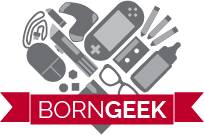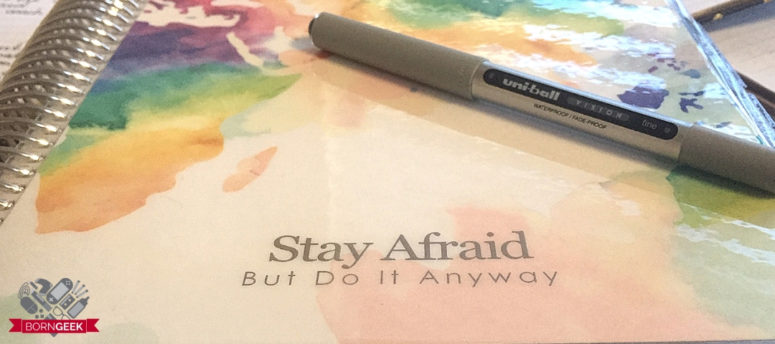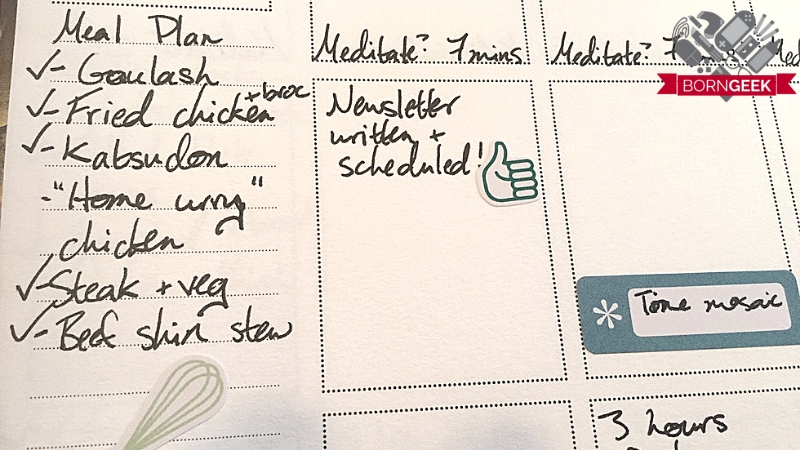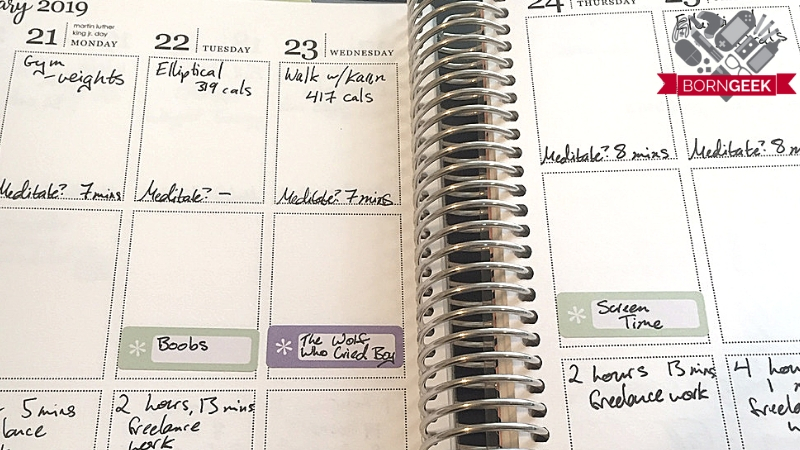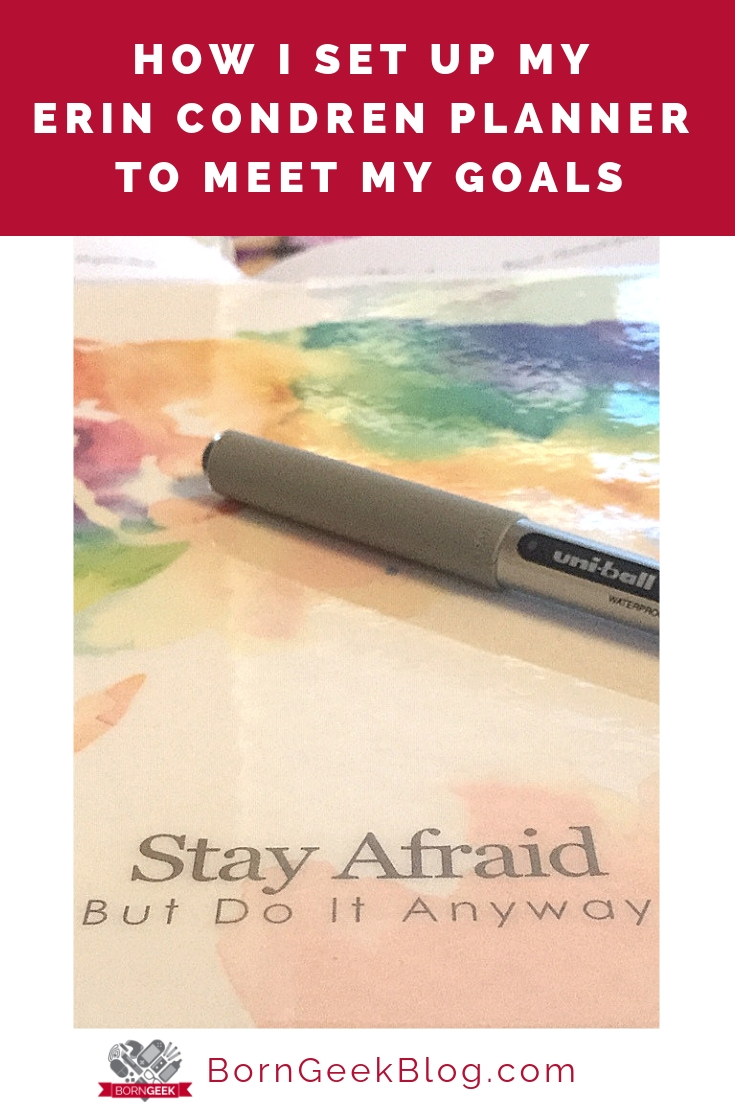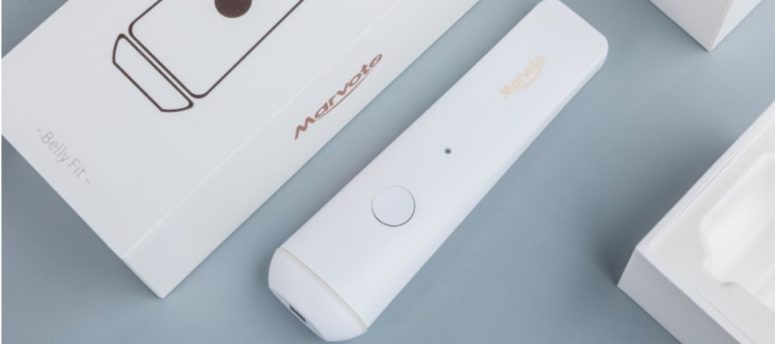I told you before that I had goals for 2019. You can read the more detailed commentary about the goals, but the core was to take care of my mental and physical health, to save some money (hopefully towards travel), and to put more time into my creative outlets like this blog, my YouTube channel and my coaching business. It’s all well and good to make goals of any kind, but it can be hard to keep track of them or take the necessary actions.
Last year, I bought my first Erin Condren planner. I really liked it. But by the end of the year, I didn’t feel like I had really used it to its full potential. So this year, I decided to set myself up for success using my Erin Condren planner, and a month into the process, I feel like I’ve found my groove. So I thought I’d share how I organized it, what’s working for me and what I want to do better.
(Full disclosure: When I decided that I wanted to write this blog, I figured I’d also sign up as an EC affiliate. This means that the links to Erin Condren stuff are connected to me, helping me earn a small commission if you decide to buy anything. Or you can use THIS link to get $10 credit when you buy and I’ll get also get some store credit to buy more stuff!)
Meal Planning
So, this isn’t rocket science. It’s not complicated. The reality is that by the end of the day, all of us get decision fatigue. We hit that afternoon slump and the last thing we want to do is be creative and come up with an answer to the dreaded question, “What’s for dinner?”
Meal planning has numerous benefits. It helps eliminate the decision fatigue drain because you’ve already made the decision of what you’re going to have for the week, and choosing between six options is easier than coming up with something out of nowhere. It also helps with grocery shopping – I can make a list and go shopping for the week. Yes, I’ve cut down on last minute grocery trips so much because I already have everything I need to make for dinner, and knowing that I was doing a “big shop” meant that I also put all the breakfast, lunch and snack supplies we would need on the list.
Because I’m planning meals and shopping once, it’s also helpful with budgeting. I wouldn’t say that we’re saving loads of money as a result, but I think I have cut down on spending a bit. I’m not making a trip to the store every couple of days for supplies, also picking up drinks, fruit, snacks and extras that “look nice”. Sure, I might still swing by the store for an extra shop on a Wednesday because we want a bottle of wine, but I’m much less likely to spend extra cash.
Also, from a health and dietary perspective, it helps to keep me on track with food. I don’t meal plan super healthy meals or anything – rarely do I list “grilled chicken breast with broccoli” as the dinner plan. But, because we do the planning and avoid decision fatigue, we’re less likely to cave and order in food. Simply by cooking the food ourselves, and deciding on portion sizes ourselves, we’re cutting calories and eating more nutritious food.
I take a VERY relaxed approach to meal planning. I sit with Dean on a Sunday or Monday and we come up with 6 meals for the list. He even had the idea that we create a menu, so on our fridge we have a list of all the meals that we can cook without research. As in, meals we’ve cooked before and know the recipe, or at least know it well enough that we only need to double check a measurement or two. As a result, we can browse the list and think of what we’re in the mood for, or compare it against what’s already in the freezer and see what we can easily make without buying more meat, veggies or other supplies.
Why only 6 dinners, I hear you ask? Because life happens. Sometimes we’re too tired and decide pizza is a better life choice. Sometimes we meet up with friends. And sometimes we’ve cooked so much all week that the fridge is filled with leftovers (even with eating them for lunch) and we’re able to scrounge around for food over the weekend.
Work Hours
As a freelancer, this is a tough one. I only get paid when I work. I know, everyone only gets paid when they work. But when you work freelance, you’re literally only paid for the hours you work on projects. As a result, I’m acutely aware of how much time I spend working each day or week. I need to work a certain number of hours per month to pay bills. I need to clock enough time if I’m going to feel productive and financially viable.
Yes, these numbers are also recorded on my invoice and the budget sheet I share with Dean. It’s not like it’s a secret how much I worked each week. But by logging it on my planner, I can see the days when work was light, or when I was slacking off. I can remind myself to work more on future days, or get a sense of how the week is shaking out.
It also helps me see trends about busy days or not so busy days. Plus it gives me a feeling of accomplishment to know exactly how much cash I earned in a week, or how I managed to push my hours more than usual.
Gym Tracking
I also keep track of which days I went to the gym or for a walk. I record the calories when FitBit decides to track the individual workout, or at least record what I did at the gym.
I’m not 100% sold on this part of my planner use. I mean, I want to keep track of exercise, and the fact that I normally write it all down means that I feel some incentive to work out so that I don’t have blank sections of my planner. But it’s just not quite as motivating as I could probably make it. I may need to come up with another way.
Blog and YouTube
One of my goals for this year was to grow this blog and continue with my YouTube channel. In order to do this, I knew that I needed a publishing schedule. I’ve stuck to my publishing schedule on YouTube for a few months now, and I’ve seen continual growth on the channel. So I made sure to integrate the YouTube publishing schedule into the planner.
But I’ve never had a solid schedule for this blog. Back in the day, I blogged five days a week. Every day I’d post a new blog about SOMETHING. Over time, my blogging became less and less frequent. I didn’t have the time, or so I thought, but I also often felt like I didn’t have something that I wanted to say every day.
So, to keep with the goal, I decided to start small again. I now publish two posts a week, and I put them in my planner as a reminder that I NEED to post something. Sometimes, I’m a day off – life still happens and I’m not going to NOT publish just because my Tuesday was super busy. I’ll make a plan and still get the blog done. By having the points in the planner, I’m reminded that a blog post is due and I need to get it written.
Meditation
I realized after I’d started to set everything up that I didn’t put anything in the planner for the meditation and mental health stuff I wanted to focus on. Even in my planner, it seemed like everything was about the hustle or the grind, about money, hours worked and quantifying my impact through the blog and YouTube channel. The whole point of my goal was to take care of myself, yet that wasn’t something that I was tracking.
So, I changed it up! I added daily reminders to track my meditation. I hate filling in a blank here, although it does happen sometimes. Just knowing that I’ll be checking in on myself in this regard encourages me to make sure that I’ve made the time to meditate. I normally do a few minutes of yoga before that, too, although I don’t count it towards my goal. I also have a monthly tally to fill in with how much I meditated through the whole month. Knowing that I found time each day, week, and month to focus, breathe and center myself has already been amazing.
Stickers!
Okay, so when I was originally investigating Erin Condren planners, people were going NUTS for all the stickers, washi tape, and other extras. It seemed like the planner was just the beginning, that the real point was the stickers. It just didn’t make sense to me. I mean, I had sticker books back in the 90s like all the other girls, but I wasn’t blown away by the idea of using stickers in my planner. Last year, I didn’t use any.
But this year’s planner came with a starter pack of them. There were icons and flags and reminders and monthly themed things. They looked silly. But then I started putting a couple of them down. And then more. And now, I adore them. I don’t want to cover my whole planner in them, but it’s really nice to be able to put something inspiring down. It’s nice to use a sticker when I send an invoice to remind me that money is coming. It’s cool to reward myself for awesome exercise with a funky, motivational sticker. I didn’t think it would be, but it’s great.
I have my eye on these sticker packs, in fact. I’ve searched on Amazon for anything similar, and I haven’t found anything quite as cool. So I guess when the next invoices roll in, I’ll be buying them to keep my spirits up.
The reality is that you can meet your goals without a fancy planner. You can set your mind to anything and track it in your own way. Use the FitBit app, record things in your calendar on your phone, or set up accountability groups with friends. But for me, I decided to make full use of my Erin Condren planner, and I’m loving it. So, if you’re considering getting an Erin Condren planner (use this link to save $10 when you do so), you might want to use some of these ideas to get it set up and make the most of it.
DID YOU LIKE THIS POST?
If you like these words, please check out more of what I say on twitter and Facebook, and pics I take on Instagram and subscribe to my YouTube channel and follow me on Pinterest.
Also, please be sure to sign up to my carefully curated, crafted and infrequent newsletter.
